PREVIEW – On September 6, 2020, the first day of principal photography on Mission: Impossible – Dead Reckoning Part One, Tom Cruise drove a motorbike off a mountain. Specifically, he drove a custom-made Honda CRF 250 off a purpose-built ramp on the side of Norway’s Helsetkopen mountain, a vertiginous rock face sat some 1,200 metres above sea level. Then he plunged 4,000 feet into the ravine below before opening his parachute barely 500 feet from the ground.
When he landed, director, Christopher McQuarrie, and the small crew of his Mission co-stars who had assembled to watch the seminal cinematic sequence from the safety of video village, breathed a collective sigh of relief. Then Cruise picked himself up and did it all again another seven times, just to make sure the footage was perfect.
“Every time I went off the ramp, it was dangerous. It was risking my life. And we wanted to keep that to a minimum,” Cruise says. “We have a saying on Mission: Impossible movies: ‘Don’t be safe. Be competent.’” He says that of course knowing the extensive training regimens and rigorous safety protocols that surround every element of the production.
The stunt was, by any measure, the most dangerous of Cruise’s career – which is saying something given that in previous Mission films he has, among other jaw-dropping endeavours, swung around the outside of the world’s tallest building (Dubai’s Burj Khalifa, in Ghost Protocol), hung onto the side of an Airbus A400M while it was in flight (in Rogue Nation) and launched himself out of a Boeing C-17 Globemaster III from a height of 25,000 feet, opening his chute just 2,000 feet from the ground and becoming the first person ever to execute a High Altitude Low Opening – or HALO – jump on film (in Fallout).
As is Cruise’s now standard practice, the motorbike jump – in which his Ethan Hunt zooms off the edge, ditches the bike and executes a high-risk BASE jump in the six-second window he has before impact – had been long in the planning. After rehearsing for a year in the UK during pre-production, by the time the cameras rolled he’d completed over 500 skydives and 13,000 motocross jumps in readiness to prepare for the most dangerous stunt he has ever completed on screen.
The truth, though, is that the stunt had been in Cruise’s head for considerably longer than that. “When I was a little kid, I used to make my own jumps, building ramps to jump my bicycle over garbage cans,” he smiles.
When Cruise was eight, – a child he now acknowledges “was always looking for dangerous stuff to do” – he found some plywood in a local construction site and assembled his biggest makeshift jump yet. “I started down a hill on my bicycle, hit the ramp, split the wood in two and smashed into some garbage cans. There was blood everywhere,” Cruise laughs. “I’ve had a lot of blood and broken bones and teeth from doing that over the years, but it’s something I’ve always wanted to do.”
In many ways these monumental moments on film have been lifetimes in the making. “Tom and I have been working together now for 16 years on what I think is close to a dozen films, and I like to describe our relationship as one long conversation about movies that’s occasionally interrupted by production,” says McQuarrie – known by the crew simply as McQ. “We eat, sleep, and breathe movies all the time. We’re constantly taking all of the knowledge that we have acquired both separately, and together, and trying to apply it to something beyond our capabilities, something beyond what we have done before.”
And, when it comes to the actual shoot, every sequence has also been rehearsed to – literally – molecular detail. The perfect example of Cruise’s constant quest for competency is his speedometer. Or, rather, his lack of one. “I needed to be at a certain speed when I jumped off the ramp [in the BASE jump stunt], but I couldn’t have a speedometer on the bike because the ramp was so narrow that if I looked down, I could come off it. So, I had to gauge the speed of the bike through the sound and vibration of the engine and by feeling the molecules in the air over my body. That was the level of competency that I had to get to,” he says.
Both McQuarrie and Cruise say they pitch each other huge stunt ideas all the time. “McQ and I have all these ideas and, sure, some are based on passions we had as kids,” Cruise says. “But now it’s up to us to not just imagine these things, but to figure out how to shoot them.” And that, they both say, is where the real fun lies.
“That’s the most dynamic aspect of the whole process of making these movies: ‘How do we approach this? What’s the training going to be? How are we going to get competent at the skills we need to achieve all this?’” Cruise smiles. “You’ve got to ask yourself: ‘How is this thing going to go?’”
The Dead Reckoning Part One crew all say that the motorbike stunt represents the pinnacle of everything the Mission: Impossible process has always stood for: An incredible feat, years in the creation, achieved through a unique mix of imagination, bravery, innovation, and dedication. But, for Cruise, the stunt was more than all that, too. It was a marker, a line in the sand. It was a mission statement.
“When I jumped off that cliff, we all jumped off that cliff,” Cruise says of the Mission cast and crew. “It was a turning point. It was like, ‘Here is the standard that we are setting. Here is the standard of film we are making. And we can’t back off from that. There’s no going back.’”
THE BIGGEST MISSION YET
Dead Reckoning Part One is the culmination of everything Cruise has learned over his four decades in the business; the product of his lifelong quest for competency in whatever discipline may be required of him at any given time.
“That’s how I’ve lived my whole life,” Cruise says. “When I needed to make money as a kid, which I did because we didn’t have any, I had to learn how to cut grass very well. On my movies, I’ve had to learn how to fly a helicopter, drive a car into traffic, jump out of a plane or off a mountain. For me, it’s the same mindset.”
For this chapter of Ethan Hunt’s story, Cruise’s commitment to tackling new things doesn’t just extend to the potentially lethal, either. For the first time in Mission: Impossible history, this movie and the next (Dead Reckoning Part Two will be released in June 2024) see Cruise and McQuarrie mark another major series milestone.
“This is the first time we’ve ever split a Mission: Impossible story over two movies. It’s something we’ve never attempted before because of the complexity of these stories. The scale of these two movies is epic in every sense,” says Cruise.
To pull off such a narrative gear shift, their ambition could be nothing but enormous. “We knew that if we were going to make a big, two-part adventure,” McQuarrie says, “these installments would have to swallow the rest of the franchise whole. That was the level we were looking at.”
Cruise remembers the moment the idea first started forming while they were shooting another ground-breaking Cruise sequel scripted by McQuarrie, which the two also produced: “We were shooting Top Gun: Maverick and we started to talk about Mission. McQ said, ‘We have to make a back-to-back.’ And that really got me,” Cruise says, “because I’ve never done a back-to-back and I like learning new things. So, when he said that it was very much like, ‘Yes, okay…’”
They knew it would be challenging. “But we also knew it would be interesting,” Cruise counters. “McQ and I had always told stories that were bursting at the seams. And this felt like a certain point, you know? I’d wanted to build up this franchise to the stage where we are today, where it’s like, ‘Now I feel that we’ve earned this moment, to be able to blow it out on this scale.’” Now, a series synonymous with pushing the envelope of action cinema was about to test its creators in ways that not even they had previously dared imagine.
“We often like to say we’re not competing with anybody but ourselves. We’re looking at the last film and figuring how can we outdo that?,” McQuarrie adds. “The sense of scale becomes bigger with each movie and the sense of limitations becomes that much smaller. You just become a little bit more adventurous every time.”
“There were times when we were making this, I want you to know, that I wasn’t sure we’d made the right call,” Cruise laughs. “There were times when we’d be shooting and McQ and I would look at each other, exhausted. And I would always turn to him and say, ‘McQ, remember, this was your idea! You talked me into this!’ I hold him fully responsible.”
It’s hard to overstate the impact that Cruise’s Mission: Impossible franchise has had on action cinema over the decades, and how it has itself grown exponentially over the same period. “Mission had done a train sequence before, all the way back in the first film and a lot of that had been done on a stage. We wanted to do one that was practical. We wanted to build upon what was learned on that sequence and apply all of that knowledge to something practical and real,” McQuarrie says, speaking about one of the film’s many jaw-dropping action sequences, in which he and Cruise drive a real steam train off a blown-up bridge (more on that later).
Over six installments and 27 years of the Mission: Impossible franchise, the character of Ethan Hunt has earned his place as one of Cruise’s most indelible creations. And, in Dead Reckoning Parts One and Two, the elite agent will be tested more than ever.
“At the start of this new movie,” executive producer Tommy Gormley says, “the question was: ‘How does it go beyond Fallout?’ That was an incredible movie and an amazing achievement.” Fallout was the biggest Mission: Impossible to date, scooping $791 million at the global box office along with the most glowing reviews of the series so far. “I was aware that whatever was coming would try and go beyond that. But I was still taken aback by the scope of ambition that McQ and Tom had for this Mission.”
In the early ‘90s, when Cruise first took the idea to make a Mission: Impossible movie to the Paramount Pictures top brass, his intentions were still ambitious but also considerably more targeted: “I wanted to bring back the kind of classic action pictures that people just weren’t making anymore,” he says now.
The original Mission: Impossible (1996) was Cruise’s first movie as a producer. “It was the very first thing I wanted to produce because I knew it would be fun,” Cruise says. “I didn’t know for sure, but I hoped it could potentially be very successful for the studio.” He wasn’t wrong. Currently, the Mission series has grossed over $3.5 billion worldwide.
“And I knew that if it was successful then we could hopefully carry on with other movies, so I could see what it was like to do that [make sequels],” Cruise says. “It also encompassed a lot of the things that I felt would be fun to play. I wanted to experiment with action, and I didn’t feel that films like that were still being explored back then; the kind of films I grew up watching in the cinema.”
To make it, Cruise enlisted as his director the iconic Brian De Palma, who over the decades had delivered an array of undisputed classics, including Carrie, Blow Out, Body Double, Dressed to Kill, Scarface, and The Untouchables among many others.
“I felt very lucky. Very lucky,” Cruise says of landing the legend. “Over my career, many different filmmakers have been very generous with me, answering my relentless questions, allowing me to see how they built their storytelling. With De Palma, I felt very grateful to work with someone with such a magnificent library of knowledge and an appreciation of cinema – and the ability to apply it to his sequences. I needed to pick up that ability. That’s why I hired him.”
The result was a hit that established a formula that would prove commercially and creatively lucrative for the next 15 years. For the three Mission movies that immediately followed, Cruise would populate their intricate spy stories with impeccable international casts and enlist each time a director with a distinct take on what Mission: Impossible could be.
“Tom’s initial approach to this franchise was this very interesting idea of having a diverse series of directors with very different visions for each movie. But what’s interesting now is how his thinking on that has evolved,” says Simon Pegg, who watched the first two Missions as a keen fan and eagerly came on board the third, as IMF analyst Benji Dunn.
“The three movies after the De Palma one were directed by John Woo, J.J. Abrams, and Brad Bird. And they were all great,” Pegg says. “But what we have now… is a continuity that’s really working for the series because you don’t have to start again each time.”
That continuity comes in the form of acclaimed writer, producer, and director Christopher McQuarrie who, in 1995 wrote The Usual Suspects, voted by the Writers Guild of America as one of The 100 Greatest Screenplays of All Time. He first met Cruise in 2006 when they collaborated on Valkyrie (which McQuarrie co-wrote and produced), beginning a filmmaking partnership that has proved pivotal for both men ever since.
“Since Chris McQuarrie joined the gang, which he did as a writer on Ghost Protocol, before directing the next four movies [Rogue Nation, Fallout, Dead Reckoning Part One and Dead Reckoning Part Two], each movie now is not someone else’s take on Mission: Impossible. What we have instead is Tom and McQ’s definitive, singular take on Mission: Impossible,” says Pegg. “And they’re fluent in it now. They know what works and how these stories need to be told. [That partnership] has given the series a real sense of continuity.”
Pegg may joke that, “I don’t think McQ quite knew what he signed up for when he came on board to help with the script for Ghost Protocol; that he would eventually be essentially the curator of these stories,” but having a single director across four consecutive movies has meant a process of constant creative refinement. A mastery of Mission.
“[In that period] we’ve been honing what makes a Mission: Impossible, a Mission: Impossible,” Pegg says. “And there are so many factors. There’s the adventure, the globe-trotting, the fun, and the action. And every time you finesse a recipe, you might change a few little bits and bobs, to try and perfect it. And McQ gets more and more adept at discovering the balance of those things, to concoct the perfect Mission: Impossible.”
Essentially, its makers say, Dead Reckoning Part One is a love letter to the whole Mission series. “It’s absolutely that,” Cruise says. “People who haven’t seen the other Missions are going to enjoy this one as a standalone experience. And the people who have seen all the other Missions will have a whole other insight into it. The story we have is very special.”
According to McQuarrie, the key to crafting that story is the emotion. “Everything that you are seeing in this movie is Tom and I focused on two things simultaneously. There is the action that we owe you because you’re coming to see a Mission: Impossible movie, and there’s the emotion that makes that action worth doing,” he says. “And we are constantly applying what we’ve learned from the last film in both of those disciplines. How to make the action bigger and how to make the emotions resonate more deeply.”
This opening chapter in that two-movie arc sees Ethan Hunt and his IMF team on their most dangerous mission yet – trying to save the world from mysterious, all-powerful enemy with the power to control the way humanity perceives reality. “The stakes in this story are as global as global stakes get,” notes McQuarrie. Not to mention the personal stakes that Ethan is faced with as he is forced to consider that nothing can matter more than his mission – not even the lives of those he cares about most.
It takes as its title an old maritime term. “In navigation, ‘dead reckoning’ is the process by which you calculate your course based solely on your last known position,” McQuarrie says. “You’re essentially flying blind. And that becomes quite the metaphor, not only for Ethan, but for several key characters.”
FRANCHISE VETERANS RETURN
Helping Ethan in his battle against bureaucrats and bad guys is the core team he’s assembled over the course of the franchise. By his side from the beginning has been Ving Rhames’ Luther Stickell, Ethan’s oldest and most trusted friend and the IMF’s legendary hacker and technical genius – also known as Phinneas Freak aka The Net Ranger – who has hacked him in and out of many perilous predicaments. As the only other person who’s appeared in every single Mission: Impossible film, Rhames is a “true veteran of the franchise,” according to McQuarrie. “[Luther] has evolved to being somebody who’s a character of great depth, empathy, sensitivity. And he’s the person who knows Ethan better than anyone else.”
The team’s other tech genius is Pegg’s Benji Dunn, introduced back in Mission: Impossible III, first as a techie back home in a cubicle and now routinely risking his own life out in the field.
“[Benji] has now grown to become an equal to Luther and Ethan, and Dead Reckoning takes him further out than he’s ever been before,” says McQuarrie.
“When Benji first appeared, he was a sort of potato character. I put on a lot of weight for that role on purpose,” Pegg deadpans. “But by now, he’s saved the world a couple of times, been close to death a couple of times,” Pegg notes of his arc. “But he’s dealing with it as best he can because the IMF is his life and he’s very dedicated to his friends.” Just like the man who plays him.
“Coming back to this franchise is always a fantastic experience,” Pegg agrees. “I’ve been in it for 18 years now, Rebecca has been for nine years. And I’ve known Tom and Ving for a long time. So, it’s always a reunion when we come back and see each other. Always a delight.”
Ask Pegg to describe Dead Reckoning Part One in three words and he’ll give you these: “A ghost story.” And it’s easy to see why, with characters from Ethan’s past coming back to haunt him.
For one, there’s Vanessa Kirby’s morally fluid Alanna Mitsopolis, aka The White Widow, who was introduced in Fallout and is a character, Pegg says, that you never quite know whether to root for. “She’s kind of a good guy, kind of a bad guy,” he surmises.
“There are a lot more twists and turns in this one, the stakes are definitely higher,” Kirby agrees of her character, a powerful and cunning arms dealer, black marketeer, and political intriguer at the center of a dark web of spies, smugglers, and cutthroats. “The White Widow really goes through something in this. She seems impenetrable. It’s a lot more complex and emotionally challenging for everybody.”
McQuarrie is excited for audience to see what Kirby does in the film, adding: “She gives a great many more sides to this character than I think anybody would expect.”
And then, of course, in a piece of casting that delighted fans when it was announced, Dead Reckoning Part One will see the return of Henry Czerny’s Eugene Kittridge, from the 1996 original. In that movie, Kittridge was a governmental company man who wrongly accused Ethan Hunt of being a mole, and got a fish tank blown up on him for his troubles. In the intervening years, he has risen to become director of the CIA, reappearing to urge his old adversary to “pick a side” in the war that potentially lies ahead.
While Cruise and McQuarrie have had conversations about Kittridge returning in the past, both knew that if he was going to return that it had to serve the story. “When we started developing Mission: Impossible Dead Reckoning – Part One, we found a way to bring Henry back in a way that was really rewarding and substantial,” says McQuarrie. “It allowed us to bookend the entire franchise and delve deeper into Ethan’s past. Because truly nobody’s known him longer in the confines of the franchise than Eugene Kittridge.”
Czerny reflects, “From Kittridge’s perspective, the Ethan Hunt he met many years ago, his mission is the same. It’s a personal mission of right and wrong, and he’s going to do whatever he can to promote an idea of compassion and rightness… However, the difference between the Ethan he met many years ago and the Ethan he’s dealing with now, is that he has much more of a maturity to him. The goal is still the same, right is might. Regardless of what happens to him.”
“Kittridge is very much an antagonist,” McQuarrie says. “But he’s not a villain. It’s more that his priorities are different [than Hunt’s], which is where the conflict arises. Under other circumstances, they would be on the same side. But Kittridge very much represents the interests of his own country and Ethan represents the interests of the entire world.”
Another franchise veteran that returns in Dead Reckoning Part One is Rebecca Ferguson, who joined the series in McQuarrie’s first Mission as director – Rogue Nation – and swiftly cemented her character Ilsa Faust as an integral and absorbing piece of the jigsaw. Ilsa’s alternatingly combative and close dynamic with Ethan having morphed, come the end of Fallout, into what feels like a genuine connection.
McQuarrie, Cruise, and Ferguson have all steadfastly refused to let the relationship between Ilsa and Ethan slip into the tropes that have often plagued the spy genre in the past. And that commitment is still very much alive and kicking in Dead Reckoning Part One. “I was never interested in Ilsa just being a typical love interest for Ethan,” McQuarrie says.
“For years we’ve talked about the relationship between them because it’s so complex,” echoes Ferguson. “The bond between these two people has been born of trauma and chaos – these are emotions that go beyond any form of love affair or kinship. Ilsa and Ethan have this pure urge to protect and support [each other], but also to have their own rights, to be right in their own ways. It’s a fascinating dynamic to play.”
Their unique relationship will continue to evolve as the story dynamic changes in this film. McQuarrie explains, “We wanted this Mission to have a sense of adventure and romance – to move away from the more serious-feeling movies we’d made prior to this, Rogue Nation and Fallout.”
Ferguson says that of the three Mission movies she’s starred in so far, Dead Reckoning Part One has seen her pull off her most impactful action sequences – “What’s the point in doing a Mission movie if you’re not going to do the odd stunt?” she says. “I think one of the reasons why Mission is such a love of my life is the training. It’s not knowing what I’m in for in the next film,” she says. “I love the fact that you never know what is going to be asked of your character to train. Whether it is a knife fight or a gun fight or its martial arts or perhaps a sword fight, which was introduced in this [film] for me.”
Crucially, Ferguson also believes that this Mission has mined the deepest emotional fissures by far. “Now we’ve hit the third film [together], there are a lot of personal issues that [all the characters] are dealing with,” she says. “There’s more of the darker aspect of each character in this Mission.”
Cruise agrees. “Emotionally, the stakes are bigger than ever. When you look at what this story is, in many ways it’s that our lives are the sum of our choices. What that means is that in this we have the permission to go much deeper into what it really means to join the IMF. That idea of, ‘should you choose to accept’ the mission. At that point, do they have a choice? And there is a choice. How you joined the Impossible Mission Force is a reflection on the IMF as a whole.”
In other words, perhaps the most tantalizing achievement of Dead Reckoning Part One is how it manages to simultaneously look to the future without ever forgetting the past. “This movie is reframing that core idea without ignoring what we’ve done. It’s encompassing all the Missions, the entire franchise,” Cruise says.
Ultimately, Cruise continues, this chapter of Ethan Hunt’s story – and that of his team – was inevitable. However good your intentions, there will always be consequences to your actions. “Ethan is a ghost. He’s someone who can impersonate people, who can be other people. And the IMF team lives a very ghost-like existence, where their past can be erased, and they can reinvent the present in the future. On paper,” Cruise says. “But, emotionally, what’s happened in the past and where those choices have led each of them still exists.”
These are the philosophical questions that Cruise and McQuarrie talked long and hard about when cracking the story for Dead Reckoning Part One and Dead Reckoning Part Two, plotting a through-line from the very start of the series to this most recent explosive installment.
“It’s about mythologizing the Impossible Mission Force,” Cruise says. “And you’ll see how that is reflected in the relationship Ethan has with Gabriel [his deadly new adversary; more on him in the next section] and with the past. There are moments between Ethan and Luther that are right there in the first Mission: Impossible and are hinted at throughout the franchise, things I always felt about how he joined the IMF. And they’re going to be revealed in Dead Reckoning Part One and Dead Reckoning Part Two.”
MEET GRACE
Dead Reckoning Part One very much continues the long-established Mission tradition of adding to its already enviable roster an ensemble of new, dynamic, and formidable characters.
A prime example is Hayley Atwell’s Grace. McQuarrie, who has described the character as “an outsider, a chaotic force of nature,” had wanted to cast Atwell in one of his movies ever since he saw her on stage, in Alexi Kaye Campbell’s London revival of The Pride, in 2013. “[She] is somebody that Tom and I have been talking about and with for well over ten years. We’ve been searching for just the right showcase for her incredible innate natural talent and presence. It’s one of the things that I love most about this movie and that I hope people take away from it,” says McQuarrie.
In The Pride there’s a scene in which Atwell’s character, Sylvia, holds a pen out to the man she knows has been having an affair with her husband, having discovered the offending item in her marital bed. As Sylvia McQuarrie his pen from her pocket, he knows that she knows.
A big part of what so drew McQuarrie to Atwell’s performance was her use of the pen in that scene. And when he and Cruise met with her, it all flooded back. “If I have a physical object to hold, it’s a transference of energy, where I feel more active and can use it to convey a character trait,” Atwell says. “And McQ liked that.”
“She’s an artful dodger, a lone wolf,” Atwell says. One who, when she steals the key to a powerful weapon from Ethan at the start of the film, sets the CIA on her and his tail, lighting the fuse on a globe-trotting chase.
Atwell describes the dynamic between Grace and Ethan as flirty, fun and spontaneous, informed by the likes of What’s Up, Doc?, Paper Moon and Broadcast News.
“When we meet Grace, she’s [working for] various people she has no emotional or moral attachment to. I think audiences will enjoy how consistently inconsistent she is,” Atwell laughs. “Just when we think we know what she’s about or what she’s up to, she does something totally different.”
Fundamentally, Atwell says, “Grace and Ethan are two people who shouldn’t be in the same room together but are forced to be because they have a shared common goal. The more she exasperates him, the funnier it becomes.” Think, Atwell suggests, the cat and mouse capery of Grace Kelly and Cary Grant in Alfred Hitchcock’s To Catch A Thief. “It’s that kind of vibe.”
Atwell’s months of physical training in mixed martial for the film gave her an advantage in her fight choreography. And being able to co-construct her character was one of the key reasons that Atwell, like all the new members of the Mission family, signed on. “Tom and McQ explained to me that they were looking for actors who would really thrive in the environment they create on Mission, which is essentially to try lots of different things and see what lands. It’s about being open to moving out of the comfort zone,” she says.
MISSION: EVOLUTION
For Cruise and McQuarrie, that process, of starting without a finalized script, has led to some of the Mission movies they’re most proud of. Even though Cruise is quick to point out that it’s a filmmaking approach that dates back decades. “Here’s the thing: that’s how I was trained to make movies. This is how I make movies. The pages don’t matter. It’s the story structure and the locations that do,” Cruise says.
“If you look at the films I make,” he continues, “there is a fluidity to the filmmaking. You want to capture moments, so it feels alive. And filmmaking is a living process – it’s not rigid. If you look back at even Risky Business or Taps, we spent a month prepping. Yes, there’s always a script and there are ideas, but the script is always evolving, changing, reloading. That’s a constant in the movies I’ve made. Rain Man, Born on the Fourth of July, every single day we were writing, evolving. But that’s not to say we don’t have a plan.”
McQuarrie adds, “We’re both learning all the time. We both see ourselves as students of the craft, not masters of it. And we really are interested first and foremost in the audience’s experience… we’re simply trying to serve the story that is presenting itself as it goes along.”
From the start of Cruise and McQuarrie’s working partnership, the pair has spent hundreds of days studying their scripts, developing them, pushing them to their peak. “I don’t want to waste time or money,” says Cruise of the painstaking, perpetual refinement. “What I want to do is put us in a position where we can win. And you do that by constantly evaluating, letting it grow. And this isn’t a new way of making films. It’s how films have been made from the beginning of cinema. Charlie Chaplin, Harold Lloyd, they were constantly looking at their stories, seeing what worked and what didn’t. Famously, Casablanca was constantly being rewritten and was constantly up in the air. This is a process.”
Sometimes the process is harder than others. “Particularly when you’re doing live action and it’s practical,” Cruise notes. Storyboards and animatics are produced, to clarify for all the departments what equipment will be needed and when. “But here’s the truth,” says Cruise. “It’s setting the table. Until you start shooting, you don’t know what’s really going to work and what’s not. That’s not for a lack of trying to predict. There’s a tremendous amount of preparation and knowledge that comes in, from all the films I’ve made and produced, and from all the films McQ and this crew has made and produced. But it’s when the cameras start rolling that the story really comes to life.”
WELCOME TO THE COMMUNITY
Someone familiar with the Cruise/McQuarrie MO is Greg Tarzan Davis, who played ‘Coyote’ in Top Gun: Maverick. Enlisted by the two to play a new character in Dead Reckoning Part One, Davis’s Degas is one half of a pair of operatives – the other being Shea Whigham’s Briggs – pursuing Ethan Hunt across the globe.
Briggs and Degas represent Clandestine Services, what McQuarrie dubs “the enforcement wing” of a cadre of top tier spymasters [played by the likes of Rob Delaney, Mark Gatiss, Charles Parnell and Indira Varma] desperate to contain the IMF’s legendarily rogue agent. “They represent the various agencies within government intelligence, referred to collectively as The Community,” explains McQuarrie.
Briggs and Degas are the agents they send out to do their dirty work. What they’re dealing with, of course, just so happens to be the most capable and canny spy on the planet, meaning their pursuit of him will take them from the dunes of Abu Dhabi to the bridges of Venice and the cobbled streets of Rome. Much of it on foot.
“[Over the course of making this movie] Shea and I have run in every country imaginable. It feels like we’re on this relay race that’s never-ending,” laughs Davis of the level of sprinting his role has required. “And we’re running after Tom Cruise, who is a man who knows how to run! We’re in such good shape now I think we should [compete] in the Olympics next.”
As well as man-marking the indomitable Ethan Hunt, the pair also has to cope with their somewhat opposing personalities. “The way Briggs and Degas see the world is completely different,” says Davis, who grew up watching the Mission movies and jumped at the chance to work with Cruise and McQuarrie for a second time. “I see Degas as being more innocent, where Briggs is more tough. We may clash on how things should be done, but we have a shared objective: to catch Ethan Hunt.”
Whigham, the coveted character actor who has starred in everything from indie hits like Take Shelter to prestige TV like Boardwalk Empire and blockbusters like Joker, shares, “I’m such a fan of this series,” Whigham says. “The two men at the top, McQ and Tom, are constantly chasing story and characters you care about. You have all the jumping continents and stuff you love about Mission, but at the same time the characters shine. Briggs is unorthodox in the way he goes about [his job]. He will do whatever it takes [to catch Hunt] and sometimes we’ll see that it’s not by the book.”
Whigham continues, “This has been as exciting as anything I’ve ever done because they just don’t make movies like this anymore… Thankfully, in the moments where you would normally be scared, like being on top of a moving train, you see Tom and I think the caveman brain in you goes, ‘It’s okay. It’s okay.’”
Another fan of the franchise is Cary Elwes, new to the mix in Dead Reckoning Part One as Denlinger, the Director of National Intelligence and head of The Community. “In the film, I am literally the only person working in Intelligence who has no idea what the IMF is,” Elwes says. “All the people who work for me have been keeping this secret from me all this time.”
Elwes was on vacation, traveling through Jordan (“I spent a lot of my childhood there”) when he got the call from McQuarrie. “It was a thrill to get it because obviously it was a chance to work with Tom again,” Elwes says. “We hadn’t worked together for 31 years, and when we did, in Florida, for Days of Thunder, I would go to watch him work even on my days off because Tom is an amazing study.”
Of all Elwes’ takeaways from working with Cruise on Days of Thunder, the biggest was this: “His energy was infectious. I remember thinking to myself, ‘I’m going to take that with me. That’s something I’m going to use.’ And he hasn’t changed in 31 years. He’s still filled with this extraordinary positive energy, and is as magnanimous, joyful, playful and excited as he was – like a kid in a candy store.” As an added bonus, Dead Reckoning Part One saw Elwes back working in the UK again – “with all my compatriots” – for the first time since he made The Princess Bride, 36 years ago.
–theGeek-

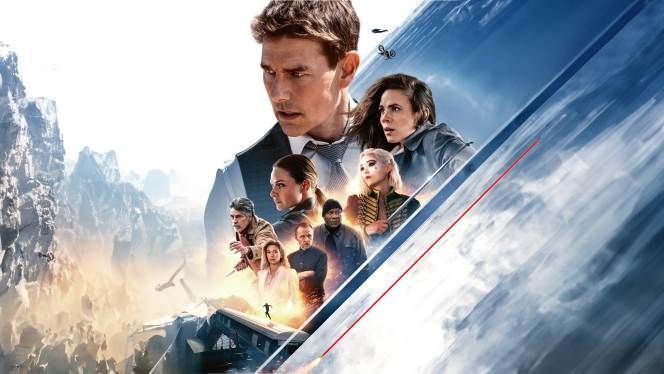
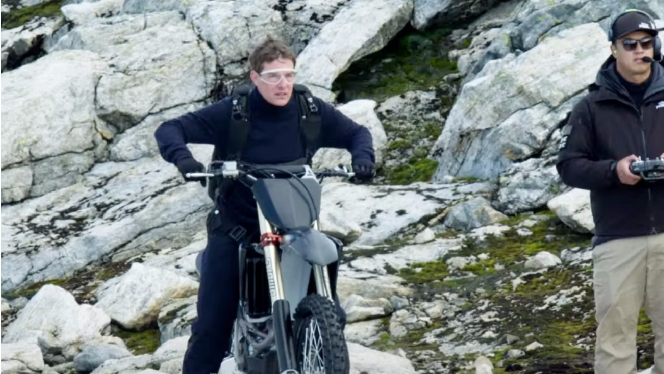
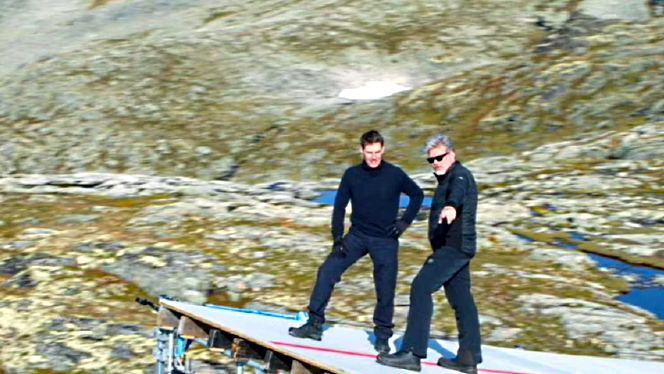
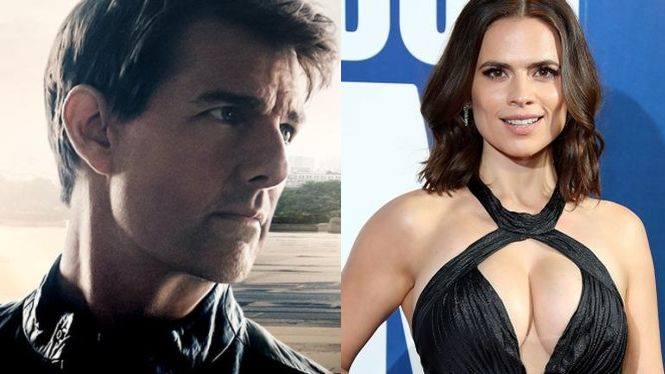
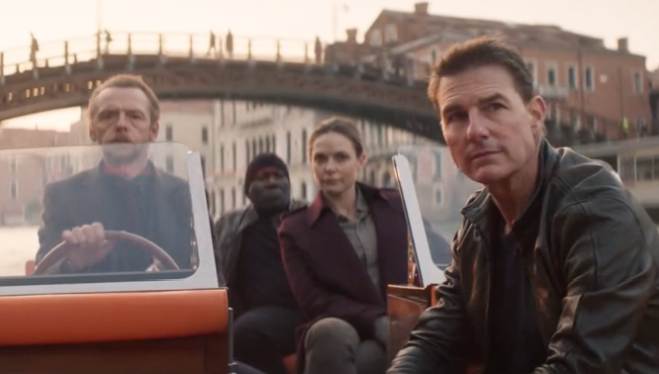




![SkyShowtime Presents the Stylish Trailer for the Spy Thriller Series PONIES [VIDEO]](https://thegeek.games/wp-content/uploads/2025/12/theGeek-A-ket-poni-302x180.jpg)

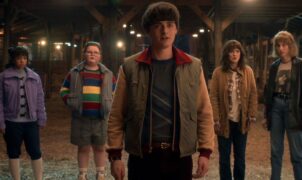

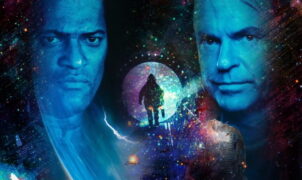
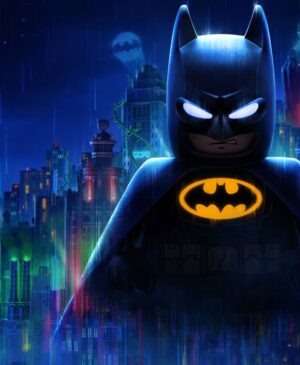
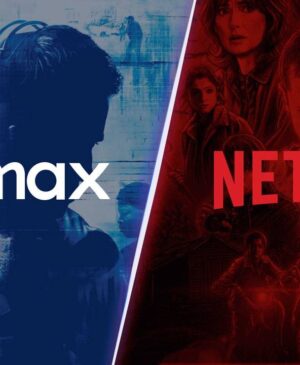
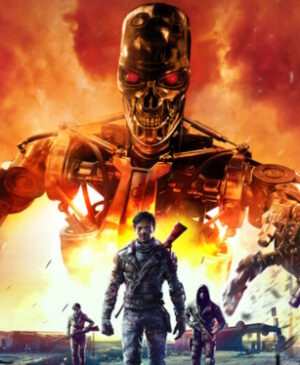
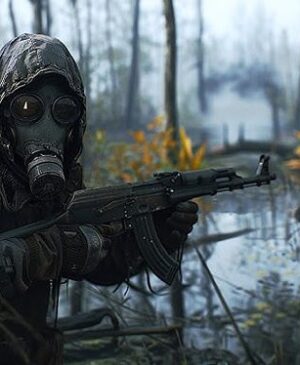
Leave a Reply